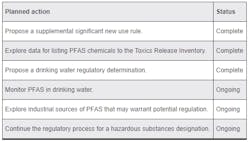Report: EPA has completed 3 of 6 actions under PFAS plan
The Government Accountability office recently released a report finding that the Environmental Protection Agency (EPA) has completed three of six selected regulatory-related actions for addressing per- and polyfluoroalkyl substances (PFAS) outlined in EPA's PFAS Action Plan . For two of the three completed actions, the steps EPA took were also in response to the National Defense Authorization Act for Fiscal Year 2020 (FY20 NDAA):
After proposing a supplemental significant new use rule in February 2020, EPA met a June 2020 deadline set in the FY20 NDAA when the EPA Administrator signed the final rule. Among other things, under the final rule, articles containing certain PFAS as a surface coating, and carpet containing certain PFAS, can no longer be imported into the U.S. without EPA review.
EPA incorporated 172 PFAS into the Toxics Release Inventory in June 2020. The FY20 NDAA directed EPA to take this action, extending EPA's original planned action to explore data for listing PFAS chemicals to the inventory.
Finally, in March 2020, EPA completed a third regulatory-related action, not required under the FY20 NDAA, when the agency proposed a preliminary drinking water regulatory determination for two PFAS—an initial step toward regulating these chemicals in drinking water.
Status of Six Selected Regulatory-Related Actions in the Environmental Protection Agency's (EPA) Per- and Polyfluoroalkyl Substances (PFAS) Action Plan
Source: GAO analysis of EPA's 2019 PFAS Action Plan. | GAO-21-37
Three of the six selected regulatory-related actions are ongoing, and EPA's progress on these actions varies. For example:
As of August 2020, EPA was developing a proposed rulemaking for a nationwide drinking water monitoring rule that includes PFAS, which EPA officials said the agency intends to finalize by December 2021.
EPA planned to continue the regulatory process for designating two PFAS as hazardous substances under the Comprehensive Environmental Response, Compensation, and Liability Act, would allow the agency to require responsible parties to conduct or pay for cleanup. On January 14, 2021, EPA issued an advance notice of proposed rulemaking for the hazardous substances designation to get public comment and data to inform the agency's ongoing evaluation of the two PFAS.
Beginning in the 1940s, scientists developed a class of heat- and stain-resistant chemicals—PFAS—that are used in a wide range of products, including nonstick cookware, waterproof clothing, and some firefighting foams. PFAS can persist in the environment for decades or longer. The Centers for Disease Control and Prevention has found that most people in the U.S. have been exposed to two of the most widely studied PFAS, likely from consuming contaminated water or food. According to EPA, there is evidence that continued exposure above certain levels to some PFAS may lead to adverse health effects. In February 2019, EPA issued its PFAS Action Plan , which outlined 23 planned actions to better understand PFAS and reduce their risks to the public.
GAO was asked to examine the status of regulatory-related actions in EPA's plan. For six regulatory-related actions GAO selected in EPA's PFAS Action Plan , this report examines (1) the number of actions that are complete and the steps EPA took to complete them and (2) the number of actions that are ongoing and EPA's progress toward completing them. GAO first identified those actions in the PFAS Action Plan that may lead to the issuance of federal regulations or could affect compliance with existing regulations. GAO then assessed the status of the actions by reviewing EPA documents and examining EPA's response to related FY20 NDAA requirements.
To read the full report, go to https://www.gao.gov/assets/720/712011.pdf

